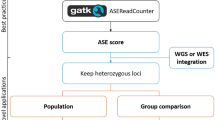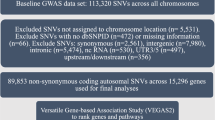Abstract
Genome-wide association (GWA) studies have significantly contributed to the understanding of human genetic variation and its impact on clinical traits. Frequently only a limited number of highly significant associations were considered as biologically relevant. Increasingly, network analysis of affected genes is used to explore the potential role of the genetic background on disease mechanisms. Instead of first determining affected genes or calculating scores for genes and performing pathway analysis on the gene level, we integrated both steps and directly calculated enrichment on the genetic variant level. The respective approach has been tested on dilated cardiomyopathy (DCM) GWA data as showcase. To compute significance values, 5000 permutation tests were carried out and p values were adjusted for multiple testing. For 282 KEGG pathways, we computed variant enrichment scores and significance values. Of these, 65 were significant. Surprisingly, we discovered the “nucleotide excision repair” and “tuberculosis” pathways to be most significantly associated with DCM (p = 10−9). The latter pathway is driven by genes of the HLA-D antigen group, a finding that closely resembles previous discoveries made by expression quantitative trait locus analysis in the context of DCM–GWA. Next, we implemented a sub-network-based analysis, which searches for affected parts of KEGG, however, independent on the pre-defined pathways. Here, proteins of the contractile apparatus of cardiac cells as well as the FAS sub-network were found to be affected by common polymorphisms in DCM. In this work, we performed enrichment analysis directly on variants, leveraging the potential to discover biological information in thousands of published GWA studies. The applied approach is cutoff free and considers a ranked list of genetic variants as input.





Similar content being viewed by others
References
Ashburner M, Ball CA, Blake JA, Botstein D, Butler H, Cherry JM, Davis AP, Dolinski K, Dwight SS, Eppig JT et al (2000) Gene ontology: tool for the unification of biology. Nat Genet 25(1):25–29
Backes C, Ruhle F, Stoll M, Haas J, Frese K, Franke A, Lieb W, Wichmann HE, Weis T, Kloos W et al (2014) Systematic permutation testing in GWAS pathway analyses: identification of genetic networks in dilated cardiomyopathy and ulcerative colitis. BMC Genom 15:622
Braun R, Buetow K (2011) Pathways of distinction analysis: a new technique for multi-SNP analysis of GWAS data. PLoS Genet 7(6):e1002101
Communal C, Sumandea M, de Tombe P, Narula J, Solaro RJ, Hajjar RJ (2002) Functional consequences of caspase activation in cardiac myocytes. Proc Natl Acad Sci USA 99(9):6252–6256
da Huang W, Sherman BT, Lempicki RA (2009) Bioinformatics enrichment tools: paths toward the comprehensive functional analysis of large gene lists. Nucleic Acids Res 37(1):1–13
Devlin B, Roeder K (1999) Genomic control for association studies. Biometrics 55(4):997–1004
Dhandapany PS, Razzaque MA, Muthusami U, Kunnoth S, Edwards JJ, Mulero-Navarro S, Riess I, Pardo S, Sheng J, Rani DS et al (2014) RAF1 mutations in childhood-onset dilated cardiomyopathy. Nat Genet 46(6):635–639
Gui H, Li M, Sham PC, Cherny SS (2011) Comparisons of seven algorithms for pathway analysis using the WTCCC Crohn’s disease dataset. BMC Res Notes 4:386
Haas J, Frese KS, Peil B, Kloos W, Keller A, Nietsch R, Feng Z, Muller S, Kayvanpour E, Vogel B et al (2015) Atlas of the clinical genetics of human dilated cardiomyopathy. Eur Heart J 36(18):1123a–1135a
Haines JL, Hauser MA, Schmidt S, Scott WK, Olson LM, Gallins P, Spencer KL, Kwan SY, Noureddine M, Gilbert JR et al (2005) Complement factor H variant increases the risk of age-related macular degeneration. Science 308(5720):419–421
Hershberger RE, Norton N, Morales A, Li D, Siegfried JD, Gonzalez-Quintana J (2010) Coding sequence rare variants identified in MYBPC3, MYH6, TPM1, TNNC1, and TNNI3 from 312 patients with familial or idiopathic dilated cardiomyopathy. Circ Cardiovasc Genet 3(2):155–161
Hindorff LA, Sethupathy P, Junkins HA, Ramos EM, Mehta JP, Collins FS, Manolio TA (2009) Potential etiologic and functional implications of genome-wide association loci for human diseases and traits. Proc Natl Acad Sci USA 106(23):9362–9367
Holle R, Happich M, Lowel H, Wichmann HE, Group MKS (2005) KORA–a research platform for population based health research. Gesundheitswesen 67(Suppl 1):S19–S25
Holmans P, Green EK, Pahwa JS, Ferreira MA, Purcell SM, Sklar P, Owen MJ, O’Donovan MC, Craddock N (2009) Gene ontology analysis of GWA study data sets provides insights into the biology of bipolar disorder. Am J Hum Genet 85(1):13–24
Jane-wit D, Altuntas CZ, Johnson JM, Yong S, Wickley PJ, Clark P, Wang Q, Popovic ZB, Penn MS, Damron DS et al (2007) Beta 1-adrenergic receptor autoantibodies mediate dilated cardiomyopathy by agonistically inducing cardiomyocyte apoptosis. Circulation 116(4):399–410
Joshi-Tope G, Vastrik I, Gopinath GR, Matthews L, Schmidt E, Gillespie M, D’Eustachio P, Jassal B, Lewis S, Wu G et al (2003) The Genome Knowledgebase: a resource for biologists and bioinformaticists. Cold Spring Harb Symp Quant Biol 68:237–243
Kanehisa M, Goto S (2000) KEGG: kyoto encyclopedia of genes and genomes. Nucleic Acids Res 28(1):27–30
Karp PD, Riley M, Paley SM, Pellegrini-Toole A (2002) The MetaCyc database. Nucleic Acids Res 30(1):59–61
Keller A, Backes C, Lenhof HP (2007) Computation of significance scores of unweighted Gene Set Enrichment Analyses. BMC Bioinform 8:290
Khatri P, Sirota M, Butte AJ (2012) Ten years of pathway analysis: current approaches and outstanding challenges. PLoS Comput Biol 8(2):e1002375
Klein RJ, Zeiss C, Chew EY, Tsai JY, Sackler RS, Haynes C, Henning AK, SanGiovanni JP, Mane SM, Mayne ST et al (2005) Complement factor H polymorphism in age-related macular degeneration. Science 308(5720):385–389
Korkmaz S, Zitron E, Bangert A, Seyler C, Li S, Hegedus P, Scherer D, Li J, Fink T, Schweizer PA et al (2013) Provocation of an autoimmune response to cardiac voltage-gated sodium channel NaV1.5 induces cardiac conduction defects in rats. J Am Coll Cardiol 62(4):340–349
Li X, Luo R, Jiang R, Chen R, Hua W (2012) Human leukocyte antigen-DQ beta 1 chain (DQB1) gene polymorphisms are associated with dilated cardiomyopathy: a systematic review and meta-analysis. Heart Lung J Crit Care 41(4):360–367
Liu G, Jiang Y, Wang P, Feng R, Jiang N, Chen X, Song H, Chen Z (2012) Cell adhesion molecules contribute to Alzheimer’s disease: multiple pathway analyses of two genome-wide association studies. J Neurochem 120(1):190–198
Lu D, Lian H, Zhang X, Shao H, Huang L, Qin C, Zhang L (2010) LMNA E82K mutation activates FAS and mitochondrial pathways of apoptosis in heart tissue specific transgenic mice. PLoS One 5(12):e15167
Meder B, Ruhle F, Weis T, Homuth G, Keller A, Franke J, Peil B, Lorenzo Bermejo J, Frese K, Huge A et al (2014) A genome-wide association study identifies 6p21 as novel risk locus for dilated cardiomyopathy. Eur Heart J 35(16):1069–1077
Pankuweit S, Ruppert V, Jonsdottir T, Muller HH, Meyer T, German Competence Network of Heart F (2013) The HLA class II allele DQB1 0309 is associated with dilated cardiomyopathy. Gene 531(2):180–183
Purevjav E, Nelson DP, Varela JJ, Jimenez S, Kearney DL, Sanchez XV, DeFreitas G, Carabello B, Taylor MD, Vatta M et al (2007) Myocardial Fas ligand expression increases susceptibility to AZT-induced cardiomyopathy. Cardiovasc Toxicol 7(4):255–263
Saccone SF, Bolze R, Thomas P, Quan J, Mehta G, Deelman E, Tischfield JA, Rice JP (2010) SPOT: a web-based tool for using biological databases to prioritize SNPs after a genome-wide association study. Nucleic Acids Res 38(Web Server issue):W201–W209
Shi T, Moravec CS, Perez DM (2013) Novel proteins associated with human dilated cardiomyopathy: selective reduction in alpha(1A)-adrenergic receptors and increased desensitization proteins. J Recept Signal Transduct Res 33(2):96–106
Subramanian A, Tamayo P, Mootha VK, Mukherjee S, Ebert BL, Gillette MA, Paulovich A, Pomeroy SL, Golub TR, Lander ES et al (2005) Gene set enrichment analysis: a knowledge-based approach for interpreting genome-wide expression profiles. Proc Natl Acad Sci USA 102(43):15545–15550
Wang K, Li M, Bucan M (2007) Pathway-based approaches for analysis of genomewide association studies. Am J Hum Genet 81(6):1278–1283
Xiao H, Wang M, Du Y, Yuan J, Cheng X, Chen Z, Zou A, Wei F, Zhao G, Liao YH (2011) Arrhythmogenic autoantibodies against calcium channel lead to sudden death in idiopathic dilated cardiomyopathy. Eur J Heart Fail 13(3):264–270
Acknowledgments
The work of AK, BM is supported by the European Union FP7 (BestAgeing). BM is grateful for support from the German Center for Cardiovascular Research (DZHK).
Author information
Authors and Affiliations
Corresponding author
Ethics declarations
Conflict of interest
The author(s) declare that they have no conflict of interests.
Additional information
C. Backes and B. Meder: equal contribution as first authors.
Electronic supplementary material
Below is the link to the electronic supplementary material.
Rights and permissions
About this article
Cite this article
Backes, C., Meder, B., Lai, A. et al. Pathway-based variant enrichment analysis on the example of dilated cardiomyopathy. Hum Genet 135, 31–40 (2016). https://doi.org/10.1007/s00439-015-1609-7
Received:
Accepted:
Published:
Issue Date:
DOI: https://doi.org/10.1007/s00439-015-1609-7




